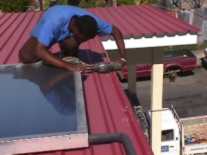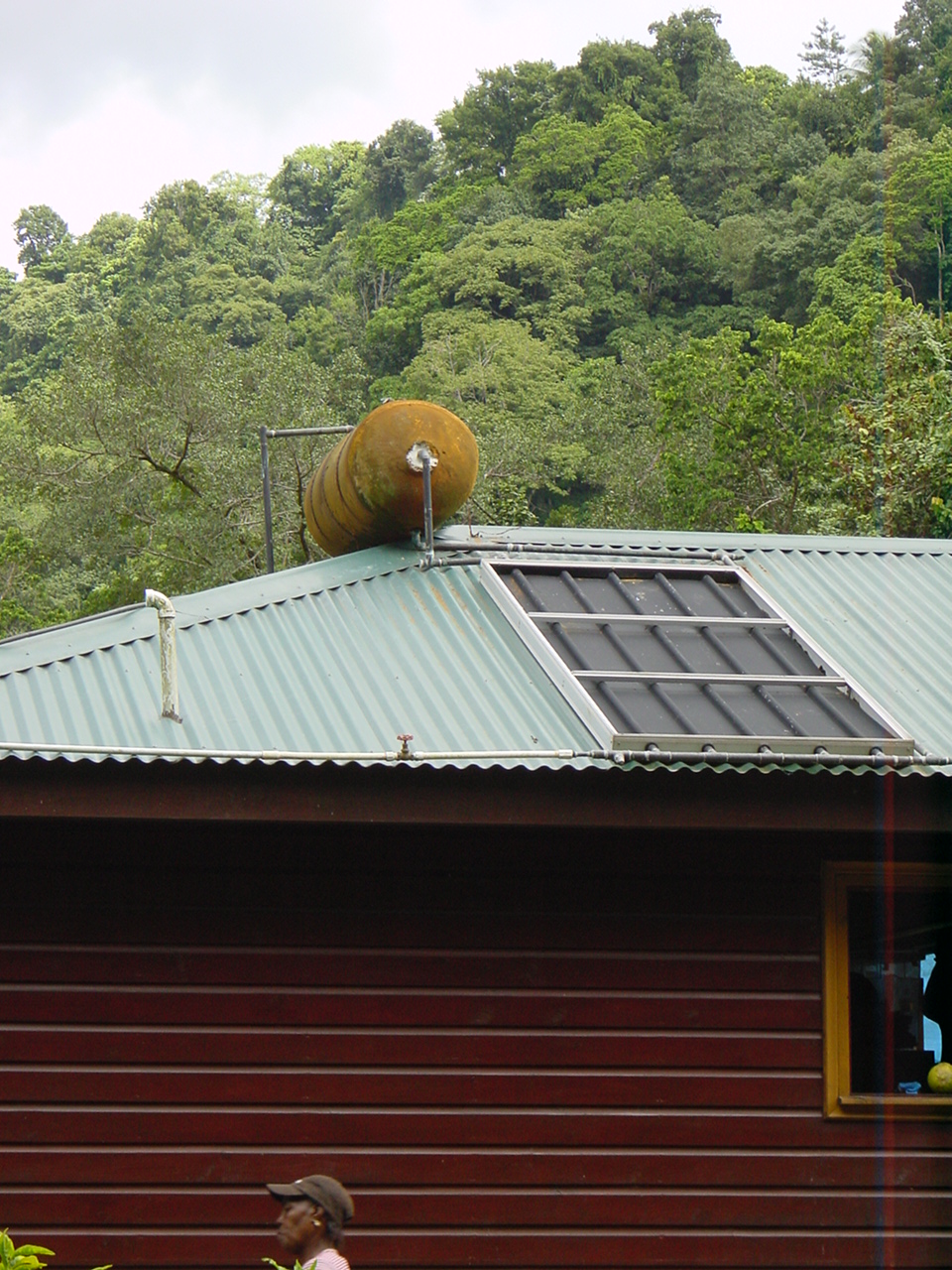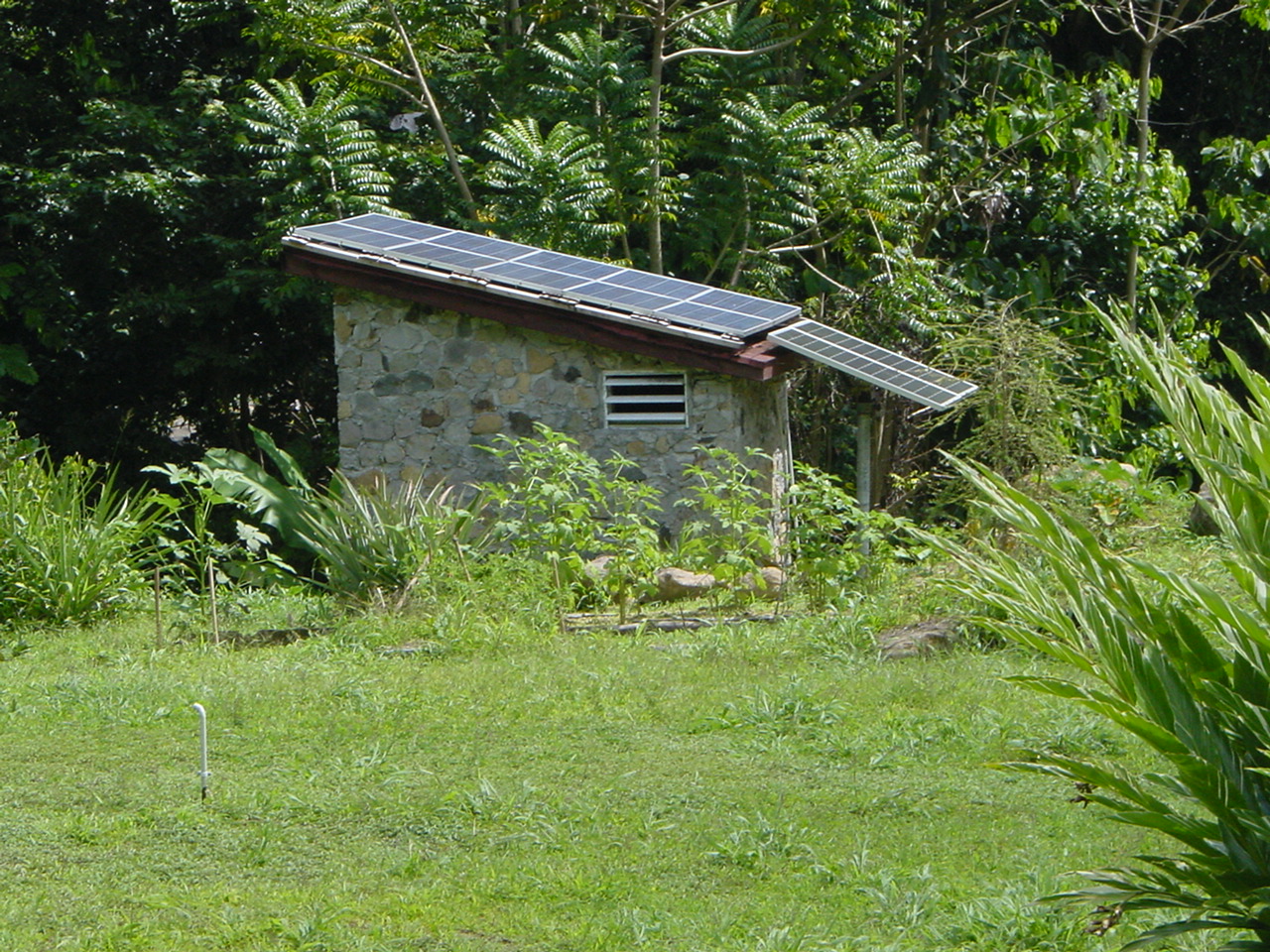Dominica, March 18-28, 2005
University of Vermont
Team Solar Group Report
Tim Ferdinand and Nicholas Laskovski


While in Dominica the solar group finally got a grasp of the market available in a relatively isolated island environment. We experienced three points on the solar market spectrum while visiting various sites. These incorporated one high output/large capacity system, one low budget/low capacity system and one system that served as a medium ground between these two extremes.
At the three rivers eco resort Jem Winston demonstrated to the class ways which one could create a low-budget solar hot water heater. The design of his system relied on the thermosyphon solar hot water heater design. He chose this particular system because it relies on the natural convection of hot water rising above cooler water, thus eliminating the need for a pump to circulate the water. By eliminating the need for a pump, Jem has already saved valuable electricity needed for other areas of the eco-resort. The components of the system were designed for the average Dominican with a limited income. Knowing this, Jem used old gasoline tanks found in cars or trucks as his solar hot water tank. When mounted on the roof the tank provided around 20 gallons of water at a time. The pipes running from the solar hot water panel to the tank have to be insulated for the convection of water to occur. Jem found that a warm climate found in Dominica reduced the need for excessive insulation of the pipes. He simply placed egg cartons over the pipes as insulation to maintain the thermosyphon effect. Jem has made the thermosyphon solar hot water heater cheap, easy to install, and easy to maintain out of concern for the natural environment of Dominica. By using these techniques, Jem hopes to facilitate an overall reduction in the fossil fuel dependence of Dominica.

PV at 3 Rivers Resort: 3 Rivers Resort also incorporated a PV array system. This system, which is hooked up to batteries, powers all of the electricity within the huts, main dining, and reception area, mostly for lighting and a laptop computer. The PV shed, shown above, had the panels on top and batteries inside. There was also a charge controller protecting the batteries and an inverter providing 220AC. Along with the stored electricity, were smaller PV direct panels which powered the water pump which distributed water from the river to the large water tank on top of the hill. This tank used gravity to distribute the water to the Solar Hot Water tanks on each of the huts. The water pump operates whenever the sun is out, and has a filter in the river where the water is obtained. A concrete basin was built in the river with rebar over the top to protect the intake and filter from rocks and debris during high water periods.
Tim F. and Nick L. had met with Head Executive Michael Astaphan of Marinor Enterprises Limited (MEL).

www.marinorsolar.com
Along with Solar Hot Water Heaters, MEL also works with plumbing repairs and services, metal fabrications, swimming pool and spa installations, etc. MEL provides the installation of personal home water systems. Different models and dimensions can be found on their website.


Marinor Solar has many projects throughout the West Indies, mainly involving Large Solar Hot Water Systems to be implemented on hotels. Currently, Mr. Astaphan is setting up a Solar Hot Water System which includes a 1,800 gallon water supply and 10 large solar water panels. Although no hands on work was done between UVM students and MEL, propositions for the future were made including the opportunity for students to become part of the Marinor Solar work force. Mr. Astaphan was very interested in the design aspects of his systems and was particularly looking for engineers who could possibly design systems for him in the future. These systems would not only include adapted solar arrays to specific building projects, but also technology improvements to make the water hotter, have more sanitary tanks, and an implemented system which would directly relate to the costs of the Solar Array to the project at hand. Meaning, with more projects coming, the ability to survey an area to estimate the cost of a project was becoming more and more difficult.
In conclusion, our connection for future work and the possibility to work on large-scale solar projects, as opposed to single home units, is within our realm of opportunity. . Let's not forget that within our meeting, we were given fresh coconuts to sip on. Possibly a bribe, but delicious nonetheless. It is up to UVM students to help Dominicans capture this abundant source of energy before the lights go out.

After reviewing last year's solar hot water project at Springfield Plantation (http://www.uvm.edu/~gflomenh/Dominica/reports/solarH2O.html) our instructor Gary Flomenhoft realized that the check-valve on the system had been installed incorrectly. The check valve is a device which allows water to flow in one direction. The check valve was installed vertically on the network of pipes to stop a possible reverse thermosyphon effect in the system during the night. The valve that was installed vertically was intended for a horizontal position. This mix up impeded the flow of water during the day, causing most of the hot water to stay in the solar panels during the day. The valve had to be removed and replaced to allow the free flow of water throughout the system. This called for basic pipe cutting using a hack saw and pipe cutter. After choosing the right alignment of pipe fittings and the necessary angles, we soldered the pipes together and installed the new piece in to the system. We removed this valve and found that when we were checking the temperature, the difference between the heated water and the cold water was much larger than when the valve was still being used. Along with fixing this valve we also performed small maintenance on the panels themselves by fixing up the insulation along the pipes and releasing air from the panels too.
A backup solar electric system was also being used at the Springfield Plantation which would power some porch lights by charging a 12 volt battery. Unfortunately, when we initially checked the system, all of the water within the battery had been used up and it was completely dry. This is extremely bad for the longevity of the batteries. We filled the battery back up. This is just to prove a point that small maintenance every so often can really make your systems last. It takes constant reminder to people who are new at dealing with these systems to make sure they check and repair their systems whenever needed.

